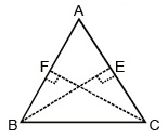Class 9 - Mathematics
Triangles - Exercise 7.3

Top Block 1
Exercise 7.3
Question : 1 : Δ ABC and Δ DBC are two isosceles triangles on the same base BC and vertices A and D are on the
same side of BC (see Fig. 7.39). If AD is extended to intersect BC at P, show that
(i) Δ ABD ≅Δ ACD
(ii) Δ ABP ≅Δ ACP
(iii) AP bisects ∠ A as well as ∠ D.
(iv) AP is the perpendicular bisector of BC.

Answer :
(i) In ΔABD and ΔACD, we have
AB = AC
AD = AD
BD = CD
ΔABD ≌ΔACD
(ii) In ΔABP and ΔACP, we have
AB = AC [Given]
So, AB = AC ⇒ ∠B = ∠C [Since angle opposite to equal sides are equal]
AP = AP [Common]
So, ΔABP ≌ ACP [SAS Criteria]
(iii) Since, ΔABP ≌ΔACP
So, their corresponding parts are congruent.
⇒ ∠BAP = ∠CAP
Hence, AP is the bisector of ∠A. ……(1)
Again, in ΔBDP and ΔCDP, we have
BD = CD [Given]
∠DBP = ∠CDP [Angles opposite to equal sides]
DP = DP [Common]
⇒ ∠BDP ≌∠CDP
So, ∠BDP ≌∠CDP [By CPCT]
Hence, DP (or AP) is the bisector of ∠D. ……(2)
From equation (1) and (2), AP is the bisector of ∠A as well as ∠D.
(iv) Since ΔABP ≌ΔACP
So, their corresponding parts are equal.
⇒ ∠APB = ∠APC
But ∠APB + ∠APC = 1800 [Linear pair]
So, ∠APB = ∠APC = 900
⇒ AP ⊥ BC
⇒ AP is the perpendicular bisector of BC
Question : 2: AD is an altitude of an isosceles triangle ABC in which AB = AC. Show that
(i) AD bisects BC (ii) AD bisects ∠ A.
Answer :

Mddle block 1
(i) In ΔABD and ΔACD, we have
AB = AC [Given]
∠B = ∠C [Angles opposite to equal sides]
AD = AD [Common]
So, ΔABD ≌ΔACD
Hence, their corresponding parts are equal.
⇒ BD = CD
⇒ D is the mid-point of BC or AD bisects BC.
(ii) Since, ΔABD ≌ ΔACD,
So, their corresponding parts are congruent.
⇒ ∠BAD = ∠CAD
⇒ AD bisects ∠A.
Question : 3 : Two sides AB and BC and median AM of one triangle ABC are respectively equal to sides PQ and QR and median PN of Δ PQR (see Fig. 7.40).
Show that:
(i) Δ ABM ≅Δ PQN
(ii) Δ ABC ≅Δ PQR

Answer :
In ΔABC, AM is a median
So, BM = BC/2 [Given] …….(1)
In ΔPQR, PN is a median.
So, QN = QR/2
⇒ BC = QR …………2
BM =QN [From equation (1) and (2)]
(i) In ΔABM and ΔPQN, we have
AB = PQ [Given]
AM = PN [Given]
BM = QN [Proved]
So, ΔABM ≌ΔPQN [SSS criteria]
(ii)Since ΔABM ≌ΔPQN
So, their corresponding parts are congruent.
⇒ ∠B = ∠Q
Now, in ΔABC and ΔPQR, we have
∠B = ∠Q [Proved]
AB = PQ [Given]
BC = QR [Given]
So, ΔABC ≌ΔPQR
Question : 4: BE and CF are two equal altitudes of a triangle ABC. Using RHS congruence rule, prove that the triangle ABC is isosceles.

Answer :
Given, BE ⊥ AC
So, ΔBEC is a right triangle such that ∠BEC = 900
Similarly, ∠CFB = 900
Now, in right ΔBEC and right ΔCFB, we have
BE = CF [Given]
BC = CB [Common]
Using RHS criteria, ΔBEC ≌ΔCFB
So, their corresponding parts are equal.
⇒ ∠BCE = ∠CBF or ∠BCA = ∠CBA
Now, in ΔABC, ∠BCA = ∠CBA
So, their opposite sides are equal.
⇒ AB = AC
Hence, ΔABC is an isosceles triangle.
Question : 5: ABC is an isosceles triangle with AB = AC. Draw AP ⊥ BC to show that ∠ B = ∠ C.
Answer :
We have AP ⊥ BC [Given]

So, ∠APB = 900 and APC = 900
In ΔABP and ΔACP, we have
∠APB = ∠APC [each = 900]
AB = AC [Given]
AP = AP [Common]
Using RHS criteria,
ΔABP ≌ΔACP
So, their corresponding parts are congruent.
⇒ ∠B = ∠C

